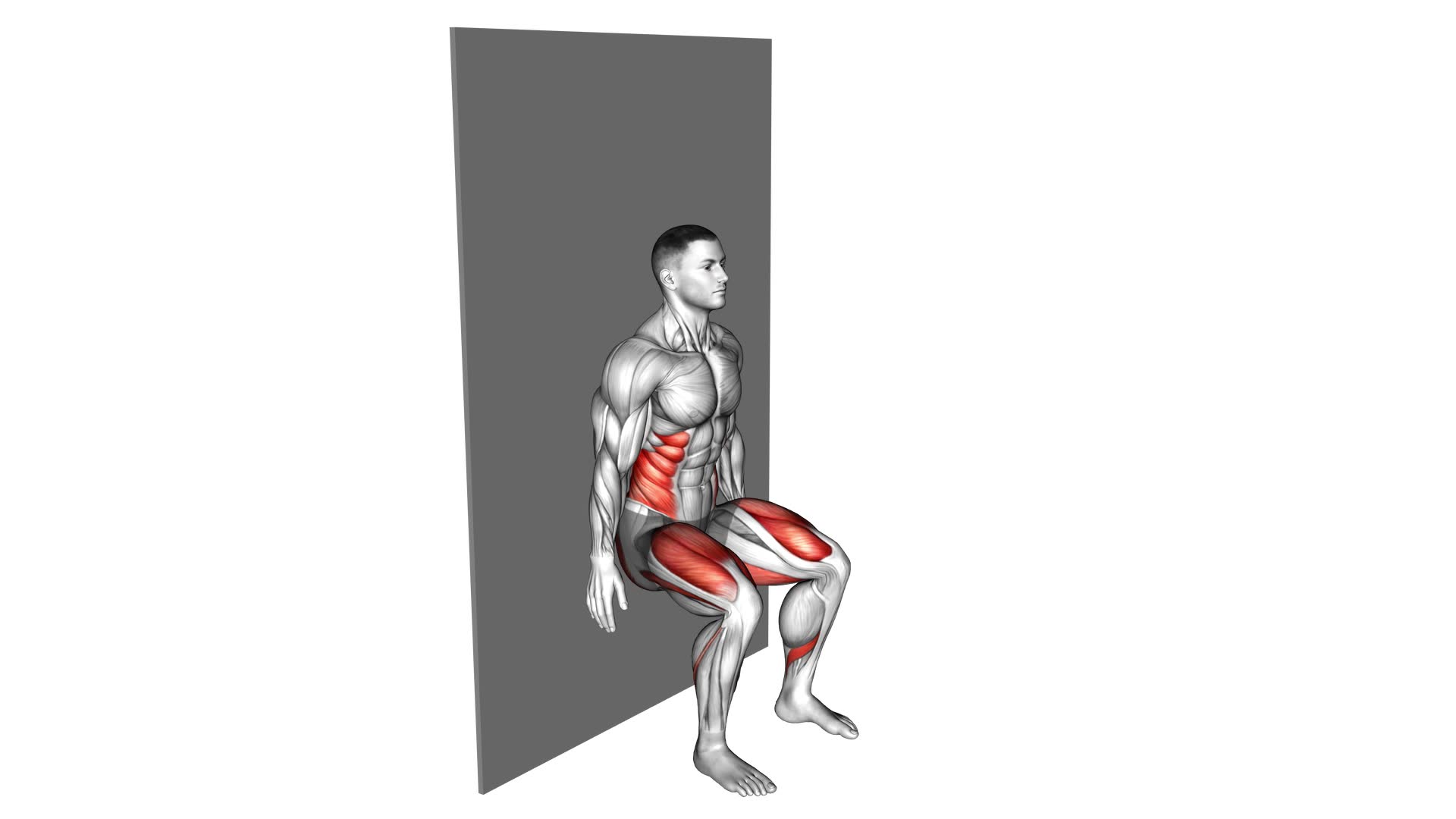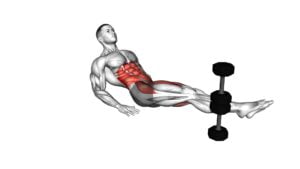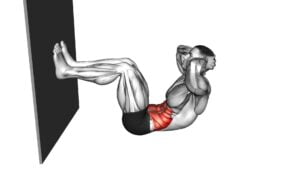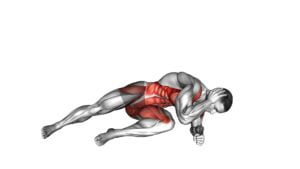Seated Side Crunch (Wall) – Video Exercise Guide & Tips

Looking to tone your obliques? The seated side crunch is the perfect exercise for you. In this video exercise guide, we'll show you the proper form and technique to get the most out of this move.
Watch This Exercise Video
Set up against a wall and follow our step-by-step guide for maximum effectiveness. Avoid common mistakes and learn how to increase intensity as you progress.
Get ready to feel the burn and sculpt those abs!
Key Takeaways
- Seated Side Crunch improves posture and strengthens the core
- Proper form and technique are important to avoid common mistakes and reduce the risk of injury
- There are advanced variations and progressions that can be incorporated to increase the challenge and effectiveness of the exercise
- Consistently engaging the core and gradually increasing resistance, range of motion, and repetitions are important for continuous improvement and results.
Benefits of the Seated Side Crunch
What are the benefits of doing the Seated Side Crunch?
The Seated Side Crunch is a powerful exercise that offers numerous benefits for your body. One of the key advantages of this exercise is its ability to improve posture. By targeting the obliques, the muscles on the sides of your abdomen, the Seated Side Crunch helps to strengthen and stabilize your core, which in turn leads to better posture.
Strong obliques also play a crucial role in supporting the spine and preventing lower back pain. Additionally, the Seated Side Crunch helps to tone and sculpt the waistline, giving you a more defined and streamlined appearance.
Proper Form and Technique
To perform the Seated Side Crunch with proper form and technique, focus on engaging your core muscles throughout the exercise.
Keep your back straight and avoid rounding your shoulders.
Be mindful of common mistakes such as using momentum or pulling on your neck.
Core Engagement Techniques
To engage your core properly and ensure proper form and technique, you can use the seated side crunch exercise against a wall.
This exercise is great for improving core stability and targeting your abdominal muscles. Start by sitting on the floor with your back against the wall and your legs bent at a 90-degree angle. Place your hands behind your head, elbows out to the sides.
Engage your core and slowly lift your upper body to one side, bringing your elbow towards your knee. Hold for a moment, then return to the starting position. Repeat on the other side.
By using the wall for support, you can maintain proper form and maximize the effectiveness of the exercise.
Now, let's move on to the next section and learn about avoiding common mistakes.
Avoiding Common Mistakes
To avoid common mistakes and ensure proper form and technique, it's important to consistently engage your core while performing the seated side crunch exercise against a wall. This will help you maintain stability and control throughout the movement, reducing the risk of injury.
To further enhance your form and technique, consider the following modifications and variations:
- Keep your back straight and shoulders relaxed.
- Avoid pulling on your neck or using momentum to lift your legs.
- Start with small movements and gradually increase the range of motion as you build strength.
Setting Up for the Exercise
Sit on a sturdy chair with your back pressed firmly against the wall. This is the starting position for the seated side crunch exercise. Before you begin, it's important to know some modifications and precautions to ensure proper execution and prevent any injuries.
For those who may have difficulty with the seated side crunch, there are modifications you can make. If you have lower back pain, you can place a small cushion or towel behind your lower back for support. Additionally, if you find it challenging to lift your legs off the ground, you can keep your feet planted on the floor throughout the exercise.
When performing the seated side crunch, it's crucial to maintain proper form and avoid common mistakes. To prevent strain on your neck, keep your gaze forward rather than looking down or to the side. Also, engage your core muscles and exhale as you crunch to the side, focusing on contracting your obliques. Avoid using momentum to swing your upper body; instead, concentrate on controlled and deliberate movements.
As with any exercise, it's essential to listen to your body and stop if you experience any pain or discomfort. If you have any existing injuries or medical conditions, consult with a healthcare professional before attempting the seated side crunch. By taking these precautions and following the correct setup, you can perform the exercise safely and effectively.
Step-by-Step Guide to Performing the Seated Side Crunch
Place your hands lightly behind your head, elbows out to the sides.
Here is a step-by-step guide to performing the Seated Side Crunch:
- Sit on the floor with your back against a wall, legs extended in front of you.
- Bend your knees and place your feet flat on the floor, hip-width apart.
- Lean slightly to one side, bringing your elbow towards your thigh on the same side. Keep your opposite hand on the floor for support.
- Exhale as you contract your oblique muscles and lift your torso towards the ceiling. Hold for a moment and then inhale as you slowly lower back down.
- Repeat the movement on the opposite side, bringing your other elbow towards your other thigh.
- Remember to engage your core throughout the exercise and maintain proper breathing techniques. Inhale at the starting position and exhale as you crunch up.
- To challenge yourself further, you can add resistance by holding a dumbbell or a medicine ball against your chest.
- Alternatively, you can also perform the Seated Side Crunch without the support of a wall, sitting on a stability ball or a bench.
Common Mistakes to Avoid
When performing the Seated Side Crunch, be mindful of the following common mistakes to avoid. First, make sure to maintain proper form throughout the exercise. It's important to keep your back straight and your core engaged. Avoid rounding your back or hunching your shoulders, as this can lead to strain and potential injuries. Additionally, be cautious not to rely solely on your arms for support. The movement should primarily come from your obliques, so avoid using excessive arm strength to lift yourself up.
Another mistake to avoid is rushing through the exercise. Take your time and focus on controlled, deliberate movements. This won't only help you avoid injuries, but also maximize the effectiveness of the exercise.
Furthermore, it's important to listen to your body and avoid pushing yourself too far. If you experience any pain or discomfort, stop the exercise and consult a professional.
By avoiding these common mistakes, you can ensure that you're performing the Seated Side Crunch correctly and safely, while also improving flexibility and avoiding injuries.
Now that you're aware of common mistakes to avoid, let's move on to the next section where we'll discuss tips for increasing intensity and progressing in the exercise.
Tips for Increasing Intensity and Progressing in the Exercise
To increase the intensity and progress in the exercise, focus on challenging your obliques and engaging your core even more. Here are some tips to help you achieve this:
- Increasing resistance: One way to make the seated side crunch more challenging is to add resistance. You can do this by holding a dumbbell or a medicine ball against your chest while performing the exercise. This added weight will require your obliques to work harder, leading to increased intensity and progress.
- Advanced variations: Once you have mastered the basic seated side crunch, you can try some advanced variations to further challenge your obliques. One option is to extend your legs straight out in front of you while performing the crunch. This will increase the leverage and make the exercise more challenging. Another option is to perform the side crunch while holding a weight overhead. This will engage your core even more and add an extra level of difficulty to the exercise.
- Increasing repetitions and sets: As you become stronger and more comfortable with the seated side crunch, you can gradually increase the number of repetitions and sets you perform. This will help to further challenge your obliques and promote progress in the exercise.
Frequently Asked Questions
How Many Calories Does the Seated Side Crunch Burn?
The seated side crunch is a great exercise for targeting your oblique muscles and improving core strength.
While it's difficult to determine the exact number of calories burned during this exercise, it can contribute to overall calorie burn and weight loss when combined with a balanced diet and regular exercise routine.
If you're looking to burn more calories, you might consider incorporating other exercises such as planks, Russian twists, or bicycle crunches into your workout routine.
Can the Seated Side Crunch Help Reduce Love Handles?
The seated side crunch can be an effective exercise for reducing love handles. By targeting the oblique muscles, it helps to strengthen and tone the sides of your waist.
However, it's important to note that spot reduction isn't possible, so combining the seated side crunch with other exercises that target the entire body is key for overall fat loss.
Incorporating cardiovascular exercises and a healthy diet will also contribute to reducing love handles.
Are There Any Modifications for People With Lower Back Pain?
If you have lower back pain, there are modifications you can make to the seated side crunch exercise. By using a cushion or a folded towel to support your lower back, you can reduce the strain on your spine. This modification allows you to still engage your core and work on strengthening your oblique muscles.
The seated side crunch is a great exercise for improving core strength, which can have numerous benefits for your overall fitness and stability.
How Many Repetitions and Sets Should I Do for the Seated Side Crunch?
For the seated side crunch, it's important to know how many repetitions and sets you should do. To make the most out of this exercise, aim for 10-15 repetitions per set.
Start with one set and gradually increase the number of sets as you get stronger.
Is It Necessary to Use a Wall for the Seated Side Crunch or Can It Be Done Without One?
Yes, it's possible to do the seated side crunch without using a wall. However, using a wall can provide additional support and stability during the exercise. It can also help you maintain proper form and target your oblique muscles effectively.
If you prefer an alternative variation, you can try using a resistance band or holding a dumbbell for added resistance. Remember to consult with a fitness professional to ensure you're performing the exercise correctly and safely.
Conclusion
The seated side crunch is a highly effective exercise for targeting the oblique muscles and improving core strength. By following the proper form and technique, you can maximize the benefits of this exercise and avoid common mistakes.
Setting up for the exercise is simple and can be done with minimal equipment. Remember to start slowly and gradually increase intensity to challenge yourself and progress in your fitness journey.
Get ready to feel the burn and see results with the seated side crunch!

Author
Years ago, the spark of my life’s passion ignited in my mind the moment I stepped into the local gym for the first time. The inaugural bead of perspiration, the initial endeavor, the very first surge of endorphins, and a sense of pride that washed over me post-workout marked the beginning of my deep-seated interest in strength sports, fitness, and sports nutrition. This very curiosity blossomed rapidly into a profound fascination, propelling me to earn a Master’s degree in Physical Education from the Academy of Physical Education in Krakow, followed by a Sports Manager diploma from the Jagiellonian University. My journey of growth led me to gain more specialized qualifications, such as being a certified personal trainer with a focus on sports dietetics, a lifeguard, and an instructor for wellness and corrective gymnastics. Theoretical knowledge paired seamlessly with practical experience, reinforcing my belief that the transformation of individuals under my guidance was also a reflection of my personal growth. This belief holds true even today. Each day, I strive to push the boundaries and explore new realms. These realms gently elevate me to greater heights. The unique combination of passion for my field and the continuous quest for growth fuels my drive to break new ground.



